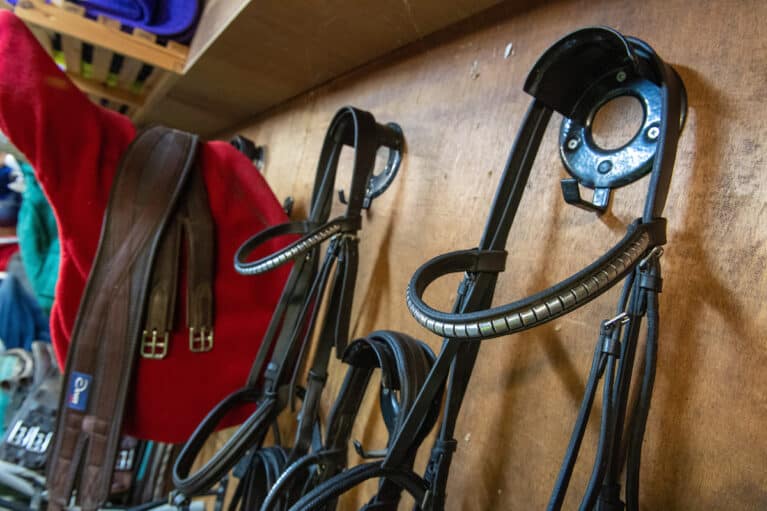Has your leatherwork seen better days? H&R explains how to bring mouldy tack back to life and prevent a relapse.

As the seasons change, it can be hard to stop the spread of damp. It softens hooves, seems to keep rugs perpetually soggy and, perhaps most frustratingly, can turn your tack green and fuzzy.
While mould prevention is better than cure, you don’t have to consign contaminated kit to the bin. With a bit of effort, you can not only get your tack looking its best again, but also prevent mould from working its way back into your tack room.
Catch mould quickly
When moisture, balmy temperatures and a sufficient food source – in this case, leather – combine, the result is an invasive mould infestation. If caught quickly, mould is easily treated, but if it’s allowed to penetrate deeper into the pores of the leather, it can become a much more time-consuming problem to solve. For this reason, it pays to be vigilant in your prevention of mould and to treat the problem as early as possible.
TOP TIP – Mould isn’t just unsightly, it also has a detrimental effect on the integrity of your kit, eating through leather and stitching. Check your tack thoroughly for any damage while you’re cleaning it and don’t use anything that’s been compromised.
Ways to cut damp in your tack room
Keeping your tack room ventilated and cutting humidity are key to preventing mould. Double-check windows and door-frames to make sure they’re tightly sealed, shutting out unwanted moisture. Opening windows during the day when the yard is under supervision allows fresh air to circulate and an electric fan can help improve the flow of clean air, too.
An electric dehumidifier can remove large quantities of moisture from the air, but ensure you choose one with an automatic shut-off function if the water tank fills to capacity, otherwise it may overflow and cause electrical issues.
If you’d prefer not to leave electrical goods running in your tack room, a silica gel or calcium chloride desiccant is a useful alternative, and pulls moisture out of the air without any need for a power source. Desiccants should be placed out of reach of children or pets. Those in plastic tubs with perforated lids are a better choice than sachets, which can be damaged more easily, potentially leading to accidental consumption. Check the desiccant tub regularly so you can empty and replace it when it’s full.
TOP TIP – Monitor rugs, saddlecloths and other fabric goods for signs of mould and mildew, too, as these can easily spread to tack. Black spots on the fabric are a tell-tale sign. For colour-fast items, washing with an antifungal detergent will kill off fungal spores.
Best practice for leather care
Although mould is most likely to affect tack that’s used infrequently or not at all, careful management of your kit can limit the conditions needed for the spores to thrive. Bear the following tips in mind in order to keep your leather at its best…
- avoid storing dirty or sweaty numnahs on top of your saddle. Bacteria and warm, damp fabric will encourage mould. Instead, remove saddlecloths and wash them or hang on a rack to dry, away from any leather goods
- clean leather after use. Sweaty, greasy leather is a breeding ground for mould. A quick wipe over with a clean, damp cloth is usually enough to keep tack in good condition
- don’t overcrowd tack hooks. Allow items such as bridles and breastplates sufficient space to dry out if they become wet. Trying to hang too many things in close proximity can create the kind of dark, moist environment in which mould thrives
TOP TIP – There’s no point putting time and effort into demoulding your tack if it’s then stored in a damp tack room. Once the moisture has invaded your walls, it’s worth taking the time to clear everything out and give the whole room a scrub with a bleach solution to stop spores at the source.
How to bring mouldy tack back to life
Although it might seem easier to simply wipe away mould, it’s important to take the time to remove it properly and kill the spores. Otherwise, even a small amount of exposure can cause a mould outbreak and the spores can spread to neighbouring tack. To do this, follow these steps…
TOP TIP – Make sure you read the directions for use on your chosen dressing or balsam. Some darker products may stain pale leather, so a light, beeswax balsam may be more suitable for your needs.
1. Completely disassemble the tack
2. Using a clean, damp rag, wipe away all visible mould. Once used, the rag should be thrown out or washed with bleach, otherwise it will harbour spores.
3. Mix one part white vinegar with two parts water in a clean bucket, or add a squirt of antibacterial dish soap to a bucket of water. Using a fresh rag and a toothbrush to help you get into crevices and fine stitching, carefully clean the leather. Allow your tack to dry in a warm, ventilated room or in the shade. Avoid direct sunlight or heat, as when combined with the astringent effect of the vinegar, this can cause leather to dry out or crack before it’s conditioned.
4. Once dry, clean your tack as normal with non-glycerine-based saddle soap, as glycerine can provide nourishment for persistent mould. Look for cleaners with antifungal properties to add a further line of defence against the recurrence of mould.
5. Condition the leather with a rich balsam or dressing to add suppleness and moisture.
6. Store your tack in a clean cover or case and make sure not to keep it near any other mouldy kit.
TOP TIP – If possible, clean mouldy tack outdoors. This prevents fungal spores from contaminating other pieces of kit in an enclosed space.
Storing tack to help prevent mould
Whether you’re storing competition kit until next season or packing away spare tack, the last thing you want is to open it up in six months’ time and discover that it’s been contaminated in storage. To avoid this, try these tips..
- store leather goods in the house. Your house is less likely to suffer from damp than your tack room, so if you can make space in your attic or utility room, this can help minimise mould
- coat it in dressing. A layer of dressing designed to protect and preserve leather can help your tack stay nourished and supple, even when not in use
- wrap it up. A saddle or bridle bag, a clean pillowcase or even newspaper can act as a shield from moisture and mould
- check on it. If your tack is being stored, set a six-monthly reminder on your phone to get it out, check for any mould or damage and apply another layer of dressing
- cut out the moisture. A sock full of cat litter or a handful of silica gel sachets can be added to a storage box to soak up any moisture
TOP TIP – Tack boxes or trunks will only keep out mould if they’re airtight. For long-term storage without the risk of fungal contamination, plastic cooler boxes are a space-efficient, cost-effective solution.










